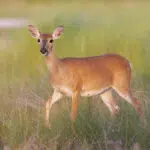Key Deer Awareness Day is observed each year on March 11 to help raise awareness about the endangered key deer. These tiny relatives to the Virginia white-tailed deer are only found in the Florida Keys, which is what influenced their name. The species has been under significant threat due to poaching, habitat loss, vehicular accidents, illnesses, and climate change, spurring the creation of a day especially to raise awareness about this cause among the public. As for the date, it was specially selected to commemorate the date key deer was given ‘endangered’ status on the Federal Register in 1967.
History of Key Deer Awareness Day
The general consensus is that key deer arrived in the Florida Key” from various places on the mainland a long time ago. Around 6,000 to 12,000 years ago, the Wisconsin Glacier melted, causing the water level surrounding this region to rise and dividing the previously long peninsula into a cluster of little islands. The deer remained stranded here — away from their mainland relatives — due to the newly formed liquid barriers. They subsequently evolved over the ages to adopt various physical characteristics and behavior patterns best suited for living on islands.
In the 1500s, a 13-year-old Spanish sailor named Hernando de Escalante Fontaneda was on his way to Spain from Cartagena. Unfortunately, his vessel was shipwrecked, and he was held captive by Native Americans for 18 years. His journey so far made it into his memoirs, and so did the mention of a very special animal — the key deer. This would also go down in history as one of the first times this species was mentioned. At the time, according to Fontaneda’s memoirs, key deer were abundant in the Keys and were seen as food by both Native Americans and those passing by.
Key deer were hunted without regulation for so long that they were pushed to the brink of extinction. By the 1940s, there were only 50 key deer in the world. Fortunately, the government and communities stepped in to rescue this species. The National Key Deer Refuge was set up in 1957, and later, various conservation laws were put in place. Law enforcement was harsher on poachers illegally hunting key deer, fencing was added along roadways to prevent the animals from wandering onto the roads, and speed limits were imposed so people could avoid hitting these animals if they did come onto the main roads. As a result, the population improved, and today, we have around 1,000 key deer living in Big Pine Key and No Name Keys — the only places they can be found today.
Key Deer Awareness Day timeline
The 8,542-acre National Key Deer Refuge in the Lower Florida Keys protects and preserves key deer and other wildlife resources.
Key deer become one of the first endangered species protected by the U.S. Endangered Species Act.
A law is passed to strictly prevent people from feeding key deer because this dangerous habit can make wildlife less scared of humans and, thus, more vulnerable to poaching.
The Trump administration cites improved numbers and elevated status as a reason for removing the key deer from the endangered species list, but there has been no conclusion for this as yet.
Key Deer Awareness Day FAQs
Where do you find key deer?
Key deer can be seen across Big Pine Key and No Name Key, on the roads, in yards, and so on.
Is it illegal to feed key deer?
Feeding key deer — and other wild animals too — is illegal and can harm them, according to experts.
What eats key deer?
Their natural predators include alligators and crocodiles, although they mostly hunt juveniles. Adult key deer are predominantly hunted by humans.
How to Observe Key Deer Awareness Day
Read up on key deer
Learn all you can about this threatened species by visiting online sources or local libraries. You can also plan a trip to the Keys to see these adorable animals in the flesh.
Share your knowledge with the world
Key deer need all the help they can get. Why fight for these fascinating creatures alone when you can recruit more volunteers to help you? Spread awareness about this species and their struggles with friends and family, and get them involved too.
Contribute to conservation causes
Research various conservation efforts being undertaken for this species. Support the causes of your choice and encourage others to do the same.
5 Key Deer Facts That Will Make You A Fa(w)n
They're also called toy deer
This is because they are tiny in comparison to their other deer cousins, with the males weighing 80 pounds and the females weighing about 60 to 65 pounds.
Baby key deer are even smaller
Tiny mom and pop deer have very small fawns — who leave hoofprints that are only the size of a human adult's fingerprint.
They can live in multiple habitats
They go to hardwood hammocks and mangroves mainly for feeding and limited sleeping, and pine Rocklands, freshwater wetlands, and button forests for all their needs.
They eat all kinds of plants
Their diet includes more than 150 different plants but they need to eat mangroves (red, white, and black) and thatch palm berries for the best nutrition.
They're great swimmers
Living in the Keys helped key deer adapt to the water very well; they are the best swimmers among most other deer species and cross from one Key island to another by swimming.
Why Key Deer Awareness Day is Important
We celebrate the smallest deer of all
In doing so, we are also helping spread essential awareness about the key deer and the problems they face in the wild. It’s crucial to their survival.
Awareness is crucial to conservation
Key deer are already so used to humans that you could just as soon find them in someone's backyard, munching away on a houseplant or two. This, unfortunately, is not good for the species, as it makes them more susceptible to human poaching and other human dangers. Understanding what actions to undertake to help conserve the key deer population — like not feeding them — is a good first step towards protecting the animals we have left.
We contribute towards a safer future
Educating the public serves to preserve more habitat for this species and will hopefully result in better legislation too. Thus, we can help resuscitate the key deer population and ensure future generations will be able to see this animal in the wild.
Key Deer Awareness Day dates
| Year | Date | Day |
|---|---|---|
| 2025 | March 11 | Tuesday |
| 2026 | March 11 | Wednesday |
| 2027 | March 11 | Thursday |
| 2028 | March 11 | Saturday |
| 2029 | March 11 | Sunday |






















